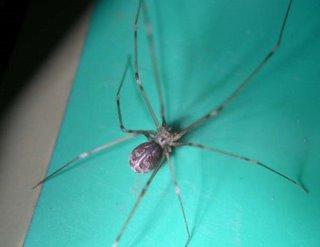Oval daddy long leg spider | Artema atlanta
Artema atlanta Walckenaer, 1837 (FAMILY: PHOLCIDAE)
Common name: Oval daddy long leg spider
Size: Female 8-10 mm, Male 5-7 mm
Distribution: Pantropical
Family identification features: Cephalothorax short and broad, almost rounded; cephalic region usually elevated on the sides with deep striations; thoracic region with deep median longitudinal fovea; clypeus high, sometimes concave beneath eyes; pedicel dorsally with two parallel or “V” shaped chitinous bands. Six or eight eyes occupying entire width of carapace, anterior medians smallest or absent, the rest large and forming two triads on each side. Sternum flat or slightly convex, broadly truncated posteriorly, wider than long; labium fused to sternum. Chelicerae chelate, weak and cylindrical; cheliceral margin with lobed or tooth-like transparent lamina. Legs extremely long, thin, fragile and slender; furnished with three claws and very short membranous onychium, tarsi flexible. Abdomen either globose or cylindrical to elongated, epigastric region well developed, triangular shaped large anal tubercle. Anterior spinnerets thick and cylindrical, slightly separated by small colulus in between; posterior spinnerets smaller, conical and compressed. Tracheal spiracle lacking in some genera. Female lacks an epigyne but has a swollen, sclerotised area on underside of abdomen. Male palp complex, large, with very small patella, tibia large and swollen, tarsus divided into two parts. A total of 6 species of 4 genera are reported from India so far.
Species description: Cephalothorax widest at posterior half, anterior half narrower and conical. A mid longitudinal crest at the anterior half of carapace, bordered by narrow brown lines, posteriorly pointed towards fovea, a longitudinal brown patch at the region of fovea; lateral region of carapace with three small brown patches arranged in a longitudinal row, well separated from lateral margin. Clypeus long and protruding downwards, both row of eyes recurved, median portion of clypeus with a brown band. Eight eyes at the tip of carapace, anterior medians at front, all the eyes grouped into two sets of three eyes. Sternum as long as wide; broadest at coxae II and III, slightly narrow at I and II and very narrow at leg IV. Labium fused with sternum. Maxillae longer than wide, more or less even in width, basal region projected inwards. Sternum a little more brownish than coxa. Abdomen globular, greyish yellow, decorated with three rows of dusky grey spots. Epigyne with a brown, thickly horny plate, with a common posterior margin.

Natural History: Commonly found in human habitations where they weave a convex dome-shaped web and an irregular network of threads that extend in all directions.
Contributed By : Sudhikumar A.V.


0 Comments:
Post a Comment
<< Home